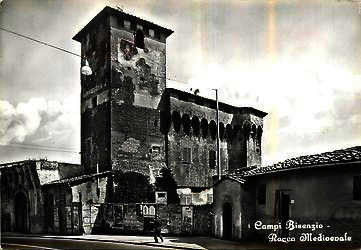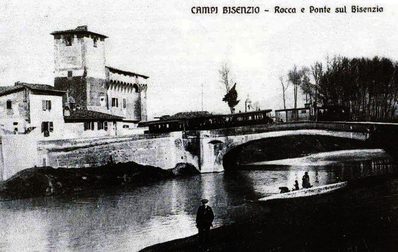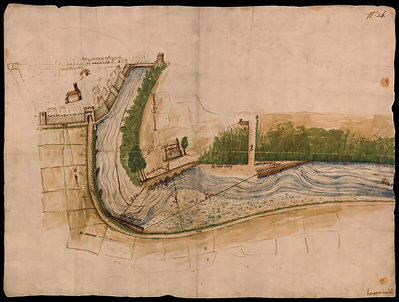
The architectural complex of the Rocca Strozzi today appears as the result of a fusion of various distinct buildings: the body of the ‘Rocca’ (or keep) itself, with its military fortifications, the various spaces that attest to the gradual transformation of the castle into a villa/farmhouse, winding around an internal courtyard, with a garden and various annexes, in which the rural structure co-exists with military architecture, and the ancient fortifications soften into the forms of a suburban villa.
The picturesque grandeur of the fortress looms large, with the high bulk of the tower, and of the ancient circling defensive wall. Its location along the river guarantees a visibility that gives rise to visual perspectives of great emotive power, evoking an original dignified pride in its austere forms, altered and sweetened through several centuries, as it became transformed into a villa-farmhouse.

The exact date of the construction of the Rocca Strozzi has not yet been determined, but its existence is cited in an act of donation made by Carlo Strozzi in favor of his sons in 1378, which describes the Rocca as a fortified palace with towers, houses, and cottages, protected by an external moat that served to integrate the fortified circuit of walls: this enclosed and protected Campi from the opposite bank of the Bisenzio river. The completion of the town walls of Campi, in fact, dates from the same years, and was decreed in 1376 by the Florentine Republic, to equip the site with a defensive bulwark, protecting the Florentine possessions in this district.
Over the years the Rocca Strozzi has often been confused with the Castello of Campi and with the Rocca dei Mazzinghi, the ancient feudatories of German origin, whose dwelling, however, was erected along the left bank of the Bisenzio several centuries earlier, then destroyed and more than once re-built following invasions and pillaging.

Gradually, the Florentine family of the Strozzi displaced the Mazzinghi in the ownership of local terrains and constructions; moved by the desire for adequate self-protection, they constructed their stronghold on the right bank of the river, in a strategic position aimed at providing tangible evidence of their increased economic and political prestige.
The massive central tower, the core structure of the Rocca complex, could date back as far as the preceding epoch, perhaps to the mid-13th century, when it incorporated a part of the old fortress of the Mazzinghi. During the first half of the 15th century, the heirs of Strozza Strozzi, the brothers Marcello and Rosso, commissioned renovation and consolidation works on the military structures of the fortress. In the 16th century invading enemy armies caused great devastations to the citadel of Campi and to the Rocca itself, both in 1512 when the Spanish troops of the Holy League ransacked the area, and in 1529 when Imperial Spanish militias under Charles V did the same. In the mid-16th century, Francesco Strozzi restored the Rocca, definitively transforming it into a suburban villa with agricultural annexes.
In the 17th century extensive pictorial decoration was carried out in several rooms, in preparation for the wedding between Filippo Strozzi and the noblewoman Francesca di Simone da Bagnano, and the agricultural activities were upgraded. In the 18th and 19th centuries the complex went through further refurbishments, until the slow decline of the Strozzi in the Lorena period.
During the 20th century the outlying properties were ceded to the local government, for the construction of the new Piazza Gramsci, amidst the urban reorganization of Campi, and then, following the extinction of the old family line, the State acquired the property in 1992, transferring it to the Municipality of Campi Bisenzio in 2002.